Kaisai KCD-48HRF32 Installation guide
- Category
- Split-system air conditioners
- Type
- Installation guide
This manual is also suitable for

CASSETTE-TYPE AIR CONDITIONER
Installation Manual
Super-Slim Four-Way Cassette
IMPORTANT NOTE:
Read this manual carefully before
installing or operating your new air
conditioning unit. Make sure to save
this manual for future reference.
KCD-24HRF32
KCD-36HRF32
KCD-48HRF32
KCD-55HRF32

Accessories .................................................... 04
Indoor Unit Parts ......................................... 09
Indoor Unit Installation Instructions ....... 10
Safety Precautions ..................................... 05
Outdoor Unit Installation ......................... 13
Outdoor Unit Installation Instructions ...... 13
Drain Joint Installation ........................................ 15
Notes on Drilling Hole in Wall .................... 15
Drainpipe Installation ............................... 16
Table of Contents
Installation Manual
Indoor Unit Installation ........................... 09
Installation Overview ............................... 08
1
2
5
3
4
6
Indoor Unit Installation ........................... 07

Page 3
Refrigerant Piping Connection....................... 18
Notes on Pipe Length and Elevation .............. 18
Refrigerant Piping Connection Instructions ...20
Wiring................................................. 23
Outdoor Unit Wiring ................... 23
Indoor Unit Wiring ...................... 24
Power Specifications ................... 25
Air Evacuation ................................................. 27
Evacuation Instructions ................................ 27
Note on Adding Refrigerant ....................... 28
Panel Installation ............................................................................................... 29
Test Run....................................................................................................................... 31
7
8
9
10
11
European Disposal Guidelines ....................................................... 32
12
Impedance Information ............................................................................ 32
13
Information servicing ............................................................................ 34
14
(for R32/R290 refrigerant only )
Caution : Risk of fire

Page 4
Accessories 1
The air conditioning system comes with the following accessories. Use all of the installation parts
and accessories to install the air conditioner. Improper installation may result in water leakage,
electrical shock and fire, or cause the equipment to fail.
Name Shape Quantity
Indoor unit
installation Installation paper template
(some models) 1
Refrigeration
Fittings Soundproof/insulation
sheath (some models) 1
Drainpipe
Fittings
Outlet pipe sheath (some
models) 1
Outlet pipe clasp (some
models) 1
Drain joint (some models) 1
Seal ring (some models) 1
Installation
Accessory (some
models)
Ceiling hook 4
Suspension bolt 4
Orifice tube (some units) 1
EMC Magnetic
Ring (some
models)
Remote
controller & Its
Frame (some
models)
others
Magnetic ring (wrap the
electric wires S1 & S2
( P & Q & E ) around
the magnetic ring twice)
Magnetic ring (Hitch it on
the connective cable
between indoor unit and
outdoor unit after
installation.)
1
1
1
2
1
1
1
1
2
——
——
——
Remote controller
Fixing screw for remote
controller holder ST2.9 x 10
Remote controller holder
Dry battery AAA
Owner’s manual
Installation manual
Remote controller illustration
S1&S2(P&Q&E)

Page 5
Safety Precautions 2
Read Safety Precautions Before Installation
Incorrect installation due to ignoring instructions can cause serious damage or injury.
The seriousness of potential damage or injuries is classified as either a WARNING or CAUTION.
Failure to observe a warning may result in death. The appliance must be installed in
accordance with national regulations.
Failure to observe a caution may result in injury or equipment damage.
WARNING
CAUTION
• An all-pole disconnection device which has at least 3mm clearances in all poles , and have a
leakage current that may exceed 10mA, the residual current device (RCD) having a rated residual
operating current not exceeding 30mA, and disconnection must be incorporated in the xed
wiring in accordance with the wiring rules.
• The appliance shall be stored so as to prevent mechanical damage from occurring.
WARNING
• Carefully read the Safety Precautions before installation.
• In certain functional environments, such as kitchens, server rooms, etc., the use of specially
designed air-conditioning units is highly recommended.
• This appliance can be used by children aged from 8 years and above and persons with reduced
physical, sensory or mental capabilities or lack of experience and knowledge if they have been
given supervision or instruction concerning use of the appliance in a safe way and understand
the hazards involved. Children shall not play with the appliance. Cleaning and user
maintenance shall not be made by children without supervision.
• Do not use means to accelerate the defrosting process or to clean, other than those
recommended by the manufacturer.
• Only trained and certified technicians should install, repair and service this air
conditioning unit.
Improper installation may result in electrical shock, short circuit, leaks, fire or other damage to
the equipment and personal property.
• Strictly follow the installation instructions set forth in this manual.
Improper installation may result in electrical shock, short circuit, leaks, fire or other damage to
the equipment.
• Before you install the unit, consider strong winds, typhoons and earthquakes that might aect
your unit and locate it accordingly. Failure to do so could cause the equipment to fail.
• After installation, ensure there are no refrigerant leaks and that the unit is operating properly.
Refrigerant is both toxic and flammable and poses a serious health and safety risk.

Page 6 Page 6
Amount of refrigerant
to be charged (kg) maximum installation
height (m) Minimum room
area (m²)
≤2.048 2.2m 4
2.048-3.0 2.2m 4
>3.0 2.2m 5
Model
(Btu/h)
≤30000
30000-48000
>48000
WARNING
•
•
Any person who is involved with working on or breaking into a refrigerant circuit should hold a
current valid certicate from an industry-accredited assessment authority, which authorises their
competence to handle refrigerants safely in accordance with an industry recognised assessment
specication.
•
•
• Servicing shall only be performed as recommended by the equipment manufacturer.
Maintenance and repair requiring the assistance of other skilled personnel shall be carried out
under the supervision of the person competent in the use of ammable refrigerants.
Appliance shall be stored in a well-ventilated area where the room size corresponds to the room
area as specied for operation.
The appliance disconnection must be incorporated with an all-pole disconnection device in the
xed wiring in accordance with the wiring rules.
•
• The appliance shall be stored in a room without continuously operating ignition sources
(for example: open ames, an operating gas appliance or an operating electric heater).
• Do not pierce or burn.
•
•
Be aware that the refrigerants may not contain an odour.
Compliance with national gas regulations shall be observed.
• The appliance shall be stored so as to prevent mechanical damage from occurring.
• Keep ventilation openings clear of obstruction.
NOTE:
The following informations are required for the units adopt R32/R290 Refrigerant.
Appliance shall be installed, operated and stored in a room with a oor area larger than X m²,
installation of pipe-work shall be kept to a minimum X m²(Please see the following form ).
The appliance shall not be installed in an unventilated space, if that space is smaller than X m²
(Please see the following form ).Spaces where refrigerant pipes shall be compliance with
national gas regulations.

Note about Fluorinated Gasses
1. This air-conditioning unit contains fluorinated gasses. For specific information on the type of gas
and the amount, please refer to the relevant label on the unit itself.
2.
Installation, service, maintenance and repair of this unit must be performed by a certified technician.
3. Product uninstallation and recycling must be performed by a certified technician.
4. If the system has a leak-detection system installed, it must be checked for leaks at least every 12
months.
5.
When the unit is checked for leaks, proper record-keeping of all checks is strongly recommended.
CAUTION
CAUTION
CAUTION
This symbol shows that a service personnel should be handling this
equipment with reference to the installation manual.
This symbol shows that information is available such as the operating
manual or installation manual.
This symbol shows that this appliance uses a ammable refrigerant. If the
refrigerant is leaked and exposed to an external ignition source, there is a
risk of re.
This symbol shows that the operation manual should be read carefully.
WARNING
CAUTION
Page 7
Explanation of symbols displayed on the indoor unit or outdoor unia
(applicable to the unit adopts R32/R290 Refrigerant only):

Installation
Overview
Installation Overview 3
123
4
5
6
78
Install the indoor unit
(Page 9)
INSTALLATION ORDER
Install the outdoor unit
(Page 12) Install the drainpipe
(Page 15)
Connect the wires
(Page 22) Connect the refrigerant pipes
(Page 19)
Evacuate the refrigeration system
(Page 25)
Install the front panel
(Page 27) Perform a test run
(Page 29)
Page 8

Page 9
Indoor Unit
Installation
Indoor Unit Installation 4
Indoor Unit Parts
Drain pump
(within indoor unit)
Drain pipe
Air outlet
Air inlet
Display panel
Front grille
Louver
Refrigerant pipe
Fig. 4.1
Safety Precautions
WARNING
• Securely install the indoor unit on a
structure that can sustain its weight. If the
structure is too weak, the unit may fall and
cause personal injury, unit and property
damage, or death.
• Install the indoor unit at a height of more
than 2.5m (8’) above the floor.
• DO NOT install the indoor unit in a
bathroom or laundry room as excessive
moisture can short the unit and corrode
the wiring.
CAUTION
• Install the indoor and outdoor units, cables,
and wires at least 1m (3.2’) from televisions
and radios to prevent static or image
distortion. Depending on the appliances,
a 1m (3.2’) distance may not be sucient.
•If the indoor unit is installed on metal,
it must be electrically grounded.

Page 10
Indoor Unit
Installation
Table 4.1: Distance from ceiling relative to height of indoor unit
MODEL Length of A (mm/inch) Length of H (mm/inch)
18 205/8 > 235/9.3
24 205/8 > 235/9.3
30 205/8 > 235/9.3
30-48 245/9.6 > 275/10.8
48-60 287/11.3 > 317/12.5
Indoor Unit Installation Instructions
NOTE: Panel installation should be done after
piping and wiring.
Step 1: Select installation location
The indoor unit should be installed in a location
that meets the following requirements:
The unit is at least 1m (39”) from the nearest
wall.
There is enough room for installation and
maintenance.
There is enough room for the connecting
pipe and drainpipe.
The ceiling is horizontal and its structure
can sustain the weight of the indoor unit.
The air inlet and outlet are not impeded.
The airflow can fill the entire room.
There is no direct radiation from heaters.
CAUTION
DO NOT install the unit in the following
locations:
In areas with oil drilling or fracking
In coastal areas with high salt content in the air
In areas with caustic gases in the air, such
as near hot springs
In areas with power fluctuations, such as
factories
In enclosed spaces, such as cabinets
In kitchens that use natural gas
In areas with strong electromagnetic waves
In areas that store flammable materials or
gas
In rooms with high humidity, such as
bathrooms or laundry rooms
RECOMMENDED DISTANCES BETWEEN THE INDOOR UNIT AND THE CEILING
The distance between the mounted indoor unit and the internal ceiling should meet the following
specifications. (See Fig. 4.2)
Fig. 4.2

Page 11
Indoor Unit
CAUTION
The unit body should align perfectly with the
hole. Ensure that the unit and the hole are the
same size before moving on.
2. Drill 4 holes 5cm (2”) deep at the ceiling hook
positions in the internal ceiling. Be sure to hold
the drill at a 90° angle to the ceiling.
3. Using a hammer, insert the ceiling hooks into
the pre-drilled holes. Secure the bolt using the
included washers and nuts.
4. Install the four suspension bolts (See Fig. 4.4). Fig. 4.4
Step 2: Hang indoor unit.
1. Use the included paper template to cut a rectangular hole in the ceiling, leaving at least 1m (39”)
on all sides. The cut hole size should be 4cm(1.6”) larger than the boby size(See Fig. 4.3).
Be sure to mark the areas where ceiling hook holes will be drilled.
Fig. 4.3
Installation

Page 12
5. Mount the indoor unit. You will need two
people to lift and secure it. Insert suspension
bolts into the unit’s hanging holes. Fasten
them using the included washers and nuts
(See Fig. 4.5).
Fig. 4.5
NOTE: The bottom of the unit should be
10 - 18mm (0.4-0.7”) higher than the ceiling
board. Generally, L (indicated in Fig. 4.6) should
be half the length of the suspension bolt or long
enough to prevent the nuts from coming o.
Fig. 4.6
CAUTION
Ensure that the unit is completely level.
Improper installation can cause the drain pipe to
back up into the unit or water leakage.
NOTE: Ensure that the indoor unit is level. The
unit is equipped with a built-in drain pump and
oat switch. If the unit is tilted against the
direction of condensate ows (the drainpipe
side is raised), the oat switch may malfunction
and cause water to leak.
Fig. 4.7
NOTE FOR NEW HOME INSTALLATION
When installing the unit in a new home, the
ceiling hooks can be embedded in advance.
Make sure that the hooks do not come loose
due to concrete shrinkage. After installing the
indoor unit, fasten the installation paper
template onto the unit with bolts (M6X12) to
determine in advance the dimension and
position of the opening on the ceiling. Follow
the instructions above for the remainder of the
installation.
Fig. 4.8
Indoor Unit
Installation

Page 13
Indoor Unit Outdoor Unit
Installation
Outdoor Unit Installation
Outdoor Unit Installation Instructions
Step 1: Select installation location.
The outdoor unit should be installed in the
location that meets the following requirements:
Place the outdoor unit as close to the indoor
unit as possible.
Ensure that there is enough room for
installation and maintenance.
The air inlet and outlet must not be
obstructed or exposed to strong wind.
Ensure the location of the unit will not be
subject to snowdrifts, accumulation of leaves
or other seasonal debris. If possible, provide
an awning for the unit. Ensure the awning
does not obstruct airflow.
The installation area must be dry and well
ventilated.
There must be enough room to install the
connecting pipes and cables and to access
them for maintenance.
The area must be free of combustible gases
and chemicals.
The pipe length between the outdoor and
indoor unit may not exceed the maximum
allowable pipe length.
If possible, DO NOT install the unit where it
is exposed to direct sunlight.
If possible, make sure the unit is located far
away from your neighbors’ property so that
the noise from the unit will not disturb them.
If the location is exposed to strong winds (for
example: near a seaside), the unit must be
placed against the wall to shelter it from the
wind. If necessary, use an awning.
(See Fig. 5.1 & 5.2)
Install the indoor and outdoor units, cables
and wires at least 1 meter from televisions or
radios to prevent static or image distortion.
Depending on the radio waves, a 1 meter
distance may not be enough to eliminate all
interference.
Fig. 5.1
Fig. 5.2
Step 2: Install outdoor unit.
Fix the outdoor unit with anchor bolts (M10)
CAUTION
• Be sure to remove any obstacles that
may block air circulation.
• Make sure you refer to Length
Specifications to ensure there is
enough room for installation and
maintenance.
Fig. 5.3
5
√
√
√
√
√
√
√
√
√
√
√
√

Page 14
Outdoor Unit
Installation
Table 5.1: Length Specifications of Split Type
Outdoor Unit (unit: mm/inch)
Table 5.2: Length Specifications of Vertical
Discharge Outdoor Unit (unit: mm/inch)
MODEL
DIMENSIONS
W H D
18 633/25 554/21.8554/21.8
24 633/25 554/21.8554/21.8
36 759/29.8 554/21.8554/21.8
36 633/25 600/23.6600/23.6
48 759/29.8 710/28710/28
60 843/33 710/28710/28
Split Type Outdoor Unit
(Refer to Fig 5.4, 5.5, 5.6, 5.10 and Table 5.1)
Vertical Discharge Type Outdoor Unit
(Refer to Fig 5.7, 5.8, 5.9 and Table 5.2)
Fig. 5.7
Fig. 5.8
Fig. 5.9
Fig. 5.6
Fig. 5.5
Fig. 5.4
Outdoor Unit Dimensions
W x H x D
Mounting Dimensions
Distance A Distance B
760x590x285 (29.9x23.2x11.2) 530 (20.85) 290 (11.4)
810x558x310 (31.9x22x12.2) 549 (21.6) 325 (12.8)
845x700x320 (33.27x27.5x12.6) 560 (22) 335 (13.2)
900x860x315 (35.4x33.85x12.4) 590 (23.2) 333 (13.1)
945x810x395 (37.2x31.9x15.55) 640 (25.2) 405 (15.95)
990x965x345 (38.98x38x13.58) 624 (24.58) 366 (14.4)
946x810x420 (37.24x31.9x16.53) 673 (26.5) 403 (15.87)
946x810x410 (37.24x31.9x16.14) 673 (26.5) 403 (15.87)
952x1333x410 (37.5x52.5x16.14) 634 (24.96) 404 (15.9)
952x1333x415 (37.5x52.5x16.34) 634 (24.96) 404 (15.9)
845x702x363 (33.27x27.6x14.3) 540 (21.26) 350 (13.8)
938x1369x392 (36.93x53.9x15.43) 634 (24.96) 404 (15.9)
900x1170x350 (35.4x46x13.8) 590 (23.2) 378 (14.88)
800x554x333 (31.5x21.8x13.1) 514 (20.24) 340 (13.39)

Page 15
NOTE: The minimum distance between the
outdoor unit and walls described in the
installation guide does not apply to airtight
rooms. Be sure to keep the unit unobstructed
in at least two of the three directions (M, N, P)
(See Fig. 5.10)
M
N
P
Fig. 5.10
NOTE: Make sure the water drains to a safe
location where it will not cause water damage
or a slipping hazard.
Fig. 5.12
Notes On Drilling Hole In Wall
You must drill a hole in the wall for the
refrigerant piping, and the signal cable that will
connect the indoor and outdoor units.
1. Determine the location of the wall hole
based on the location of the outdoor unit.
2. Using a 65-mm (2.5”) core drill, drill a hole
in the wall.
NOTE: When drilling the wall hole, make
sure to avoid wires, plumbing, and other
sensitive components.
3. Place the protective wall cu in the hole.
This protects the edges of the hole and will
help seal it when you nish the installation
process.
Outdoor Unit
Installation
Fig. 5.11
300 cm / 118” or more
60 cm / 23.6”
or more
150 cm / 59”
or more
25 cm / 9.8”
or more
25 cm / 9.8”
or more
Rows of series installation
L ≤ H L ≤ 1/2H
L A
25 cm / 9.8” or more
1/2H < L ≤ H
30 cm / 11.8” or more
L H Can not be installed
Table 5.3 The relations between H, A and L
are as follows.
Drain Joint Installation
If the drain joint comes with a rubber seal
(see Fig. 5.12 - A ), do the following:
1. Fit the rubber seal on the end of the drain joint
that will connect to the outdoor unit.
2. Insert the drain joint into the hole in the base
pan of the unit.
3. Rotate the drain joint 90° until it clicks in place
facing the front of the unit.
4. Connect a drain hose extension (not included)
to the drain joint to redirect water from the
unit during heating mode.
If the drain joint doesn’t come with a rubber
seal (see Fig. 5.12 - B ), do the following:
1. Insert the drain joint into the hole in the base
pan of the unit. The drain joint will click in
place.
2. Connect a drain hose extension (not included)
to the drain joint to redirect water from the
unit during heating mode.

Page 16
Drainpipe
Installation
NOTE ON DRAINPIPE INSTALLATION
• When using an extended drainpipe, tighten
the indoor connection with an additional
protection tube to prevent it from pulling
loose.
• The drainpipe should slope downward at a
gradient of at least 1/100 to prevent water
from flowing back into the air conditioner.
• To prevent the pipe from sagging, space
hanging wires every 1-1.5m (40-59”).
• If the outlet of the drainpipe is higher than
the body’s pump joint, provide a lift pipe for
the exhaust outlet of the indoor unit. The
lift pipe must be installed no higher than
75cm (29.5”) from the ceiling board and
the distance between the unit and the lift
pipe must be less than 30cm (11.8”).
Incorrect installation could cause water to
flow back into the unit and flood.
• To prevent air bubbles, keep the drain hose
level or slightly tiled up (<75mm / 3”).
Fig. 6.3
NOTE: When connecting multiple drainpipes,
install the pipes as shown in Fig 6.4.
Fig. 6.4
The drainpipe is used to drain water from the
unit. Improper installation may cause unit and
property damage.
CAUTION
• Insulate all piping to prevent condensation,
which could lead to water damage.
• If the drainpipe is bent or installed
incorrectly, water may leak and cause a
malfunction of the water- level switch.
• In HEAT mode, the outdoor unit will
discharge water. Ensure that the drain hose
is placed in an appropriate area to avoid
water damage and slippage due to frozen
drain water.
• DO NOT pull the drainpipe forcefully as this
could cause it to disconnect.
NOTE ON PURCHASING PIPES
This installation requires a polyethylene tube
(outside diameter = 3.7-3.9cm, inside diameter
= 3.2cm), which can be obtained at your local
hardware store or from your dealer.
Indoor Drainpipe Installation
Install the drainpipe as shown in Figure 6.2.
1. Cover the drainpipe with heat insulation to
prevent condensation and leakage.
2. Attach the mouth of the drain hose to the
unit’s outlet pipe. Sheath the mouth of the
hose and clip it rmly with a pipe clasp.
(Fig 6.1)
Fig. 6.1
Drainpipe Installation 6
Fig. 6.2

Page 17
Drainpipe
Installation
3. Using a 65-mm (2.5”) core drill, drill a hole in
the wall. Make sure that the hole is drilled at a
slight downward angle, so that the outdoor
end of the hole is lower than the indoor end
by about 12mm (0.5”). This will ensure proper
water drainage (See Fig. 6.5). Place the
protective wall cu in the hole. This protects
the edges of the hole and will help seal it
when you nish the installation process.
Fig. 6.5
NOTE: When drilling the wall hole, make sure to
avoid wires, plumbing, and other sensitive
components.
4. Pass the drain hose through the wall hole.
Make sure the water drains to a safe location
where it will not cause water damage or a
slipping hazard.
NOTE: The drainpipe outlet should be at least
5cm (1.9”) above the ground. If it touches the
ground, the unit may become blocked and
malfunction. If you discharge the water directly
into a sewer, make sure that the drain has a U
or S pipe to catch odors that might otherwise
come back into the house.

Page 18
Refrigerant Piping
Connection
Refrigerant Piping Connection 7
Safety Precautions
WARNING
• All eld piping must be completed by a
licensed technician and must comply with
the local and national regulations.
• When the air conditioner is installed in a
small room, measures must be taken to
prevent the refrigerant concentration in
the room from exceeding the safety limit
in the event of refrigerant leakage. If the
refrigerant leaks and its concentration
exceeds its proper limit, hazards due to
lack of oxygen may result.
• When installing the refrigeration system,
ensure that air, dust, moisture or foreign
substances do not enter the refrigerant
circuit. Contamination in the system may
cause poor operating capacity, high
pressure in the refrigeration cycle,
explosion or injury.
• Ventilate the area immediately if there is
refrigerant leakage during the installation.
Leaked refrigerant gas is both toxic and
flammable. Ensure there is no refrigerant
leakage after completing the installation
work.
Notes On Pipe Length and Elevation
Ensure that the length of the refrigerant pipe, the
number of bends, and the drop height between
the indoor and outdoor units meets the
requirements shown in Table 7.1:
Table 7.1: The Maximum Length And Drop
Height Based on Models. (Unit: m/ft.)
Type of model Capacity
(Btu/h) Length of
piping Maximum drop
height
North America,
Australiaand the
eu frequency
conversion Split
Type
<15K 25/82 10/32.8
≥15K - <24K 30/98.4 20/65.6
≥24K - <36K 50/164 25/82
≥36K - ≤60K 65/213 30/98.4
Other Split Type
12K 15/49 8/26
18K-24K 25/82 15/49
30K-36K 30/98.4 20/65.6
42K-60K 50/164 30/98.4
Refrigerant Piping with Twin Indoor Units
When installing multiple indoor units to a single
outdoor unit, ensure that the length of the
refrigerant pipe and the drop height between
the indoor and outdoor
units meets the following
requirements:
Fig. 7.1
CAUTION
Fig. 7.2
Please purchase the ttings according to the
requirements in the manual strictly.
Refer the diagram when installing.(See Fig. 7.2)
Mark the data plate with the Orice
installed(for some models).
Liquid side
Indoor Outdoor
Liquid side
Indoor
Outdoor
X
Liquid side
Indoor
Outdoor
X

Page 19
Refrigerant Piping
Connection
Fig. 7.3 Fig. 7.4
Oil traps
CAUTION
•
If the indoor unit is installed higher than the
outdoor unit:
An oil trap should be installed every 10m
(32.8ft) of vertical suction line riser.
(See Fig. 7.3)
-If oil flows back into the outdoor unit’s
compressor, this might cause liquid
compression or deterioration of oil return.
Oil traps in the rising gas piping can prevent
this.
CAUTION
The indoor unit is installed higher than the
outdoor unit
If the outdoor unit is installed higher than the
indoor unit:
-It is recommended that vertical suction risers
not be upsized. Proper oil return to the
compressor should be maintained with suction
gas velocity. If velocities drop below7.62m/s
(1500fpm (feet per minute)), oil return will be
decreased. An oil trap should be installed every
6m(20ft) of vertical suction line riser.
(See Fig. 7.4)
The outdoor unit is installed higher than the
indoor unit

Page 20
Refrigerant Piping
Connection
Table 7.2
Permitted length
Piping
length
Total piping length 18K+18K 30/98’ L+Max
(L1, L2)
24K+24K
30K+30K
50/164’
(farthest distance from
the line pipe branch)
15/49’ L1, L2
(farthest distance from
the line pipe branch)
10/32.8’ L1-L2
Drop
height
Drop height between
indoor and outdoor unit
20/65.6’ H1
Drop height between
two indoor units
0.5/1.6’ H2
Refrigerant Piping Connection Instructions
CAUTION
• The branching pipe must be installed
horizontally. An angle of more than 10° may
cause malfunction.
• DO NOT install the connecting pipe until
both indoor and outdoor units have been
installed.
• Insulate both the gas and liquid piping to
prevent water leakage.
Step1: Cut pipes
When preparing refrigerant pipes, take extra
care to cut and flare them properly. This will
ensure efficient operation and minimize the
need for future maintenance.
1. Measure the distance between the indoor
and outdoor units.
2. Using a pipe cutter, cut the pipe a little
longer than the measured distance.
CAUTION
DO NOT deform pipe while cutting. Be extra
careful not to damage, dent, or deform the pipe
while cutting. This will drastically reduce the
heating efficiency of the unit.
1. Make sure that the pipe is cut at a perfect 90°
angle. Refer to Fig. 7.5 for examples of bad cuts
Fig. 7.5
Step 2: Remove burrs.
Burrs can aect the air-tight seal of refrigerant
piping connection. They must be completely
removed.
1. Hold the pipe at a downward angle to
prevent burrs from falling into the pipe.
2. Using a reamer or deburring tool, remove
all burrs from the cut section of the pipe.
Fig. 7.6
Step 3: Flare pipe ends
Proper flaring is essential to achieve an airtight
seal.
1. After removing burrs from cut pipe, seal
the ends with PVC tape to prevent foreign
materials from entering the pipe.
2. Sheath the pipe with insulating material.
3. Place flare nuts on both ends of pipe.
Make sure they are facing in the right
direction, because you can’t put them on
or change their direction after flaring. See
Fig. 7.7
Fig. 7.7
Page is loading ...
Page is loading ...
Page is loading ...
Page is loading ...
Page is loading ...
Page is loading ...
Page is loading ...
Page is loading ...
Page is loading ...
Page is loading ...
Page is loading ...
Page is loading ...
Page is loading ...
Page is loading ...
Page is loading ...
Page is loading ...
Page is loading ...
Page is loading ...
Page is loading ...
Page is loading ...
-
 1
1
-
 2
2
-
 3
3
-
 4
4
-
 5
5
-
 6
6
-
 7
7
-
 8
8
-
 9
9
-
 10
10
-
 11
11
-
 12
12
-
 13
13
-
 14
14
-
 15
15
-
 16
16
-
 17
17
-
 18
18
-
 19
19
-
 20
20
-
 21
21
-
 22
22
-
 23
23
-
 24
24
-
 25
25
-
 26
26
-
 27
27
-
 28
28
-
 29
29
-
 30
30
-
 31
31
-
 32
32
-
 33
33
-
 34
34
-
 35
35
-
 36
36
-
 37
37
-
 38
38
-
 39
39
-
 40
40
Kaisai KCD-48HRF32 Installation guide
- Category
- Split-system air conditioners
- Type
- Installation guide
- This manual is also suitable for
Ask a question and I''ll find the answer in the document
Finding information in a document is now easier with AI
Related papers
-
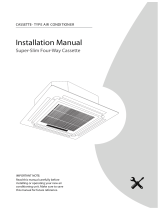 Kaisai KCD-36HRF47 Installation guide
Kaisai KCD-36HRF47 Installation guide
-
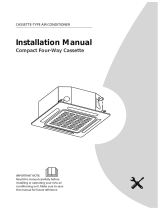 Kaisai KCA3U-18HRF32X Installation guide
Kaisai KCA3U-18HRF32X Installation guide
-
 Kaisai KUE-24HRF32 Installation guide
Kaisai KUE-24HRF32 Installation guide
-
SystemAir KTI-18HWF32 Owner's manual
-
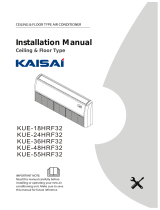 Kaisai ceiling floor R32 Installation guide
Kaisai ceiling floor R32 Installation guide
-
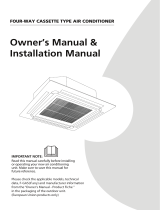 AlpicAir ACI-53HRDC1A User manual
AlpicAir ACI-53HRDC1A User manual
-
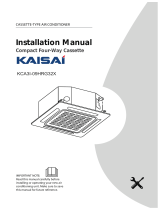 SystemAir SYSPLIT CASSETTE 18 EVO HP Q Installation guide
SystemAir SYSPLIT CASSETTE 18 EVO HP Q Installation guide
-
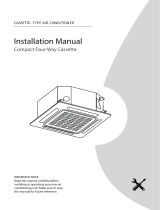 Kaisai KCA3U-12HRF47 Installation guide
Kaisai KCA3U-12HRF47 Installation guide
-
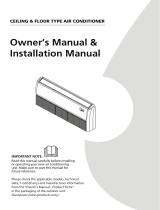 Kaisai KUE-48HRG32X Installation guide
Kaisai KUE-48HRG32X Installation guide
Other documents
-
COMFORT-AIRE B-VMH24CU-1 Operating instructions
-
innovair CE36C2DB2 Installation guide
-
Klimaire KDIS060-H2G1 Installation guide
-
Klimaire KTIM036-H2 Installation guide
-
SystemAir SYSPLIT DUCT 24 LNS HP Q Owner's manual
-
Cooper&Hunter CH12LCDTUICHHYP12SPH230VO Installation guide
-
Cooper & Hunter CH-M09DTUI Installation guide
-
 Ramsond RHDZ-27-18DT/18WM User manual
Ramsond RHDZ-27-18DT/18WM User manual
-
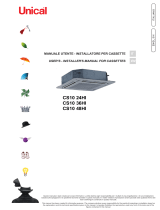 Unical CS10 - Cassette Installation guide
Unical CS10 - Cassette Installation guide
-
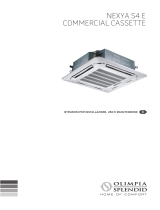 Olimpia Splendid Nexya S4 E Cassette Inverter Commercial Installation guide
Olimpia Splendid Nexya S4 E Cassette Inverter Commercial Installation guide


















































